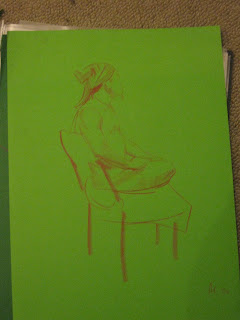Usually I begin by drawing small studies into my sketchbook in pen or pencil, sometimes favoring a brush pen when the pose suits it. Poses start at 2 minutes, and gradually increase in time, the final pose being between 30 minutes and an hour. Because I usually choose work on smaller drawings, the shorter poses suit me. On longer poses I tend to lose concentration and lose interest.

Over the weeks I have attended this class I have used a number of drawing tools, such as charcoal, pen, pencil, conte, brushpen and coloured pencils. Approaching the figure from life, I find the structure of the figure the most interesting. Light, musculature, line and tone are all aspects relevant to studying and observing the figure, however the structure is crucial in establishing a convincing figure. By structure, I am referring to the interlocking anatomy and shapes of the figure. How the ribcage connects with the arms and neck, how the bottom connects with the leg, how each limb is connected. It is this approach that seems the most logical to me, although it doesn’t suit everyone.
Walking around the life drawing room reveals a number of different intentions and styles. Some artists prefer to draw solely the face, some make only gestural marks indicating the flow of the figure.

Each week there is usually a different model. Having variation in models has allowed me to see how different and similar bodies are. Some models are thin, their ribcages visible, thighs slender and long, other models are larger, rounder, with softer curves. Model variation allows the artist to draw the figure with different approaches. Drawings of thin models suit hard line drawings and sharp silhouettes, with the emphasis on slender lines. Larger models suit drawings with heavy tone, usage of charcoal for getting light and shade looking 3-d.
Having both male and female models has also shown me how variation in drawing style suits different shapes. Men have squarer torsos, more suited to cubes and rectangles. Women have more elegant torsos, suited to curvy lines.
Life Drawing has been a crucial part of my extension studies program. It has allowed me to interact with other artists and observe the figure from life (primary research) and has been integral in the practical component of this study. The life drawings I complete are part of my folio, with some being part of the exhibition.
No comments:
Post a Comment